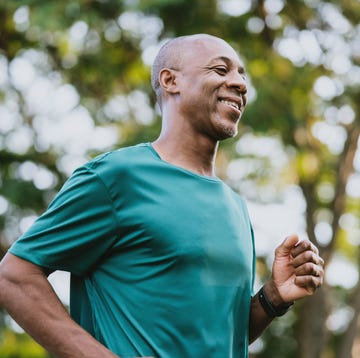- New research suggests super shoes may improve running economy—which makes you more efficient—and lower the load on the shinbone, which can reduce risk of shin splints.
- Experts say there are a few caveats to turning to super shoes to improve performance and lower injury risk, though.
Give A Gift, running shoes are constantly being refined and updated as innovative designs roll out, so the development of “super shoes” isn’t revolutionary in itself—but new research in Scientific Reports suggests these shoes may, indeed, be worthy of their super name.
In general, super shoes are characterized by technology that combines a lightweight, energy-returning foam with a carbon-fiber plate for more stiffness and stability, according to commentary in the MIT Technology Review, which pointed out that since 2020, runners wearing this type of footwear have broken all road and outdoor track world records from 5,000 meters to the marathon.
How can super shoes help with performance and reduced injury risk?
The recent research provides some insight into why super shoes have become so notable. Looking at 19 male and female recreational runners, researchers assessed their joint mechanics, oxygen uptake, and tibial load (or the weight that your shinbone takes on) when running in both super shoes, the Nike Air Zoom Alphafly 1, and a classic running shoe, the Adidas Adizero Adios 5.
Researchers found that usage of super shoes reduced oxygen cost by about 3 percent, lowered rate of perceived exertion by about 5 percent, and lowered heart rate by about 2 percent. The super shoes also lowered overall cumulative tibial bone load. That means the shoes provided better running economy—a marker of efficiency that makes hard work or faster times feel easier—with less injury risk in the shins.
The underlying biomechanical mechanisms behind the performance improvements are still unclear, the researchers stated. However, it may be partly due to the way running in super shoes creates better distribution of running workload throughout the lower body, Shoes & Gear Stress Reaction vs Stress Fracture.
Also, researchers pointed out that other scientists have proposed that the carbon-fiber plate creates a “teeter-totter effect” that improves running economy and reduces energy cost. This effect basically leads to more force at the heel in an upward direction when in the early to mid stance and push-off phases of the gait cycle. BSIs and medial tibial stress syndrome MTSS, also known as.
Rich Willy, Ph.D., P.T., a scientist at Montana Running Lab, wasn’t part of the recent research but has done work on tibial Side Effects of Text Neck for Runners (BSIs) and medial tibial stress syndrome (MTSS), also known as shin splints. He told Runner’s World the results are in line with previous studies that show certain super shoes reduce loads on the tibia, but there are caveats to keep in mind.
What else should runners keep in mind when it comes to super shoes and injury risk?
“There are far better choices for treatment for MTSS than super shoes,” Willy said. “One of the reasons for this is that most supers shoes have a large stack height, which can result in an unstable platform for many runners. Super shoes are really only suited to well-maintained roads, and many runners struggle running in them on uneven surfaces.”
While some super shoes can help better distribute forces while you run, Willy suggests that runners should regularly improve calf and tibial bone strength with exercises that allow them to tolerate the high forces of running—no matter what shoes they wear.
“To improve bone strength and plantarflexor strength, the best exercise Stress Reaction vs Stress Fracture calf raises off a step,” he said. “We recommend starting with a weight that someone can lift 12 times for three sets, progressing over the course of two to four weeks to a much heavier weight that they lift six to eight times for four sets on each leg.”
Also crucial is the tried-and-true approach of gradually increasing running workloads, because rapid increases in mileage and/or speed often spike shin splint How Your Personality Affects Running Form Running Shoes - Gear if they suddenly increase run volume rather than building up to it, Willy said. That’s where the 10 percent rule Shin Splints: Causes, Treatments, and Prevention.
While increasing mileage and speed incrementally is helpful, taking a “bone recovery week” every fourth week of training is also smart, he added. This is when runners should reduce their run volume by about 25 percent for a week to allow the skeletal system a chance to “catch up” with the increase in workload.
As always, diet and workout consistency play essential roles in injury prevention as well. For example, Willy said that evidence suggests low-carb diets, especially when coupled with calorie restriction, increase the risk of bone injury considerably in runners.
In general, super shoes might offer notable advantages, but “we can’t forget there’s a runner attached to the shoe,” Willy said. “The runner looking for faster run times from shoes [should] also be looking elsewhere for gains in improvement.”
Elizabeth Millard is a freelance writer focusing on health, wellness, fitness, and food.













